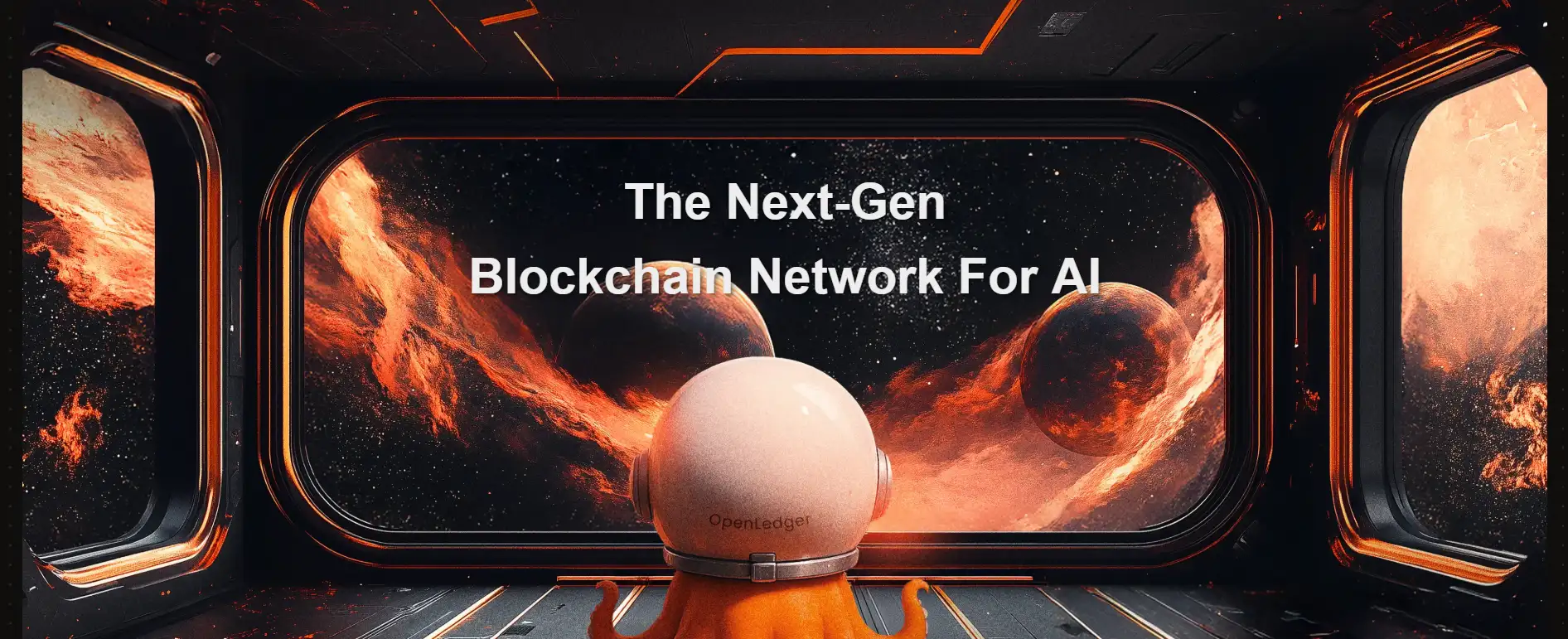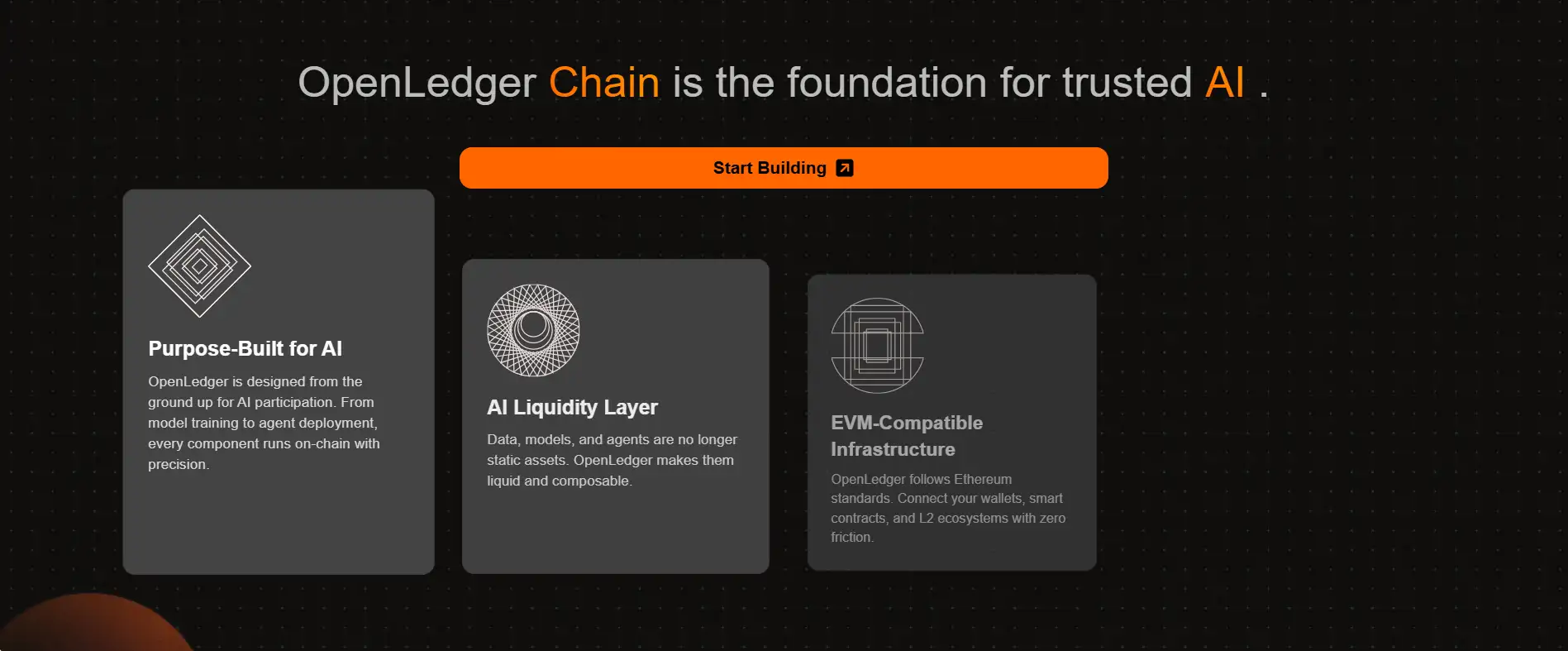About OpenLedger
OpenLedger is a cutting-edge blockchain network purpose-built to support the next generation of AI innovation. At its core, OpenLedger aims to unlock the liquidity of AI assets—including data, models, and agents—making them fully monetizable, composable, and traceable on-chain. It redefines what it means to bring intelligence on-chain by combining an EVM-compatible, modular blockchain infrastructure with tools for collaborative AI development and governance.
Positioned at the intersection of Web3 and AI, OpenLedger empowers developers, researchers, and companies to train, deploy, and scale intelligent agents and models while retaining full ownership and control. The project fosters a transparent and equitable AI economy using primitives like attribution-proofing, agent monetization, and decentralized collaboration. With major backers like Polychain and thought leaders such as Balaji Srinivasan and Sebastien Borget, OpenLedger is driving real momentum in reshaping how AI is built and distributed in the Web3 era.
OpenLedger is a specialized layer-one blockchain designed to power a decentralized AI economy where every participant—whether providing data, training models, or deploying intelligent agents—is recognized and fairly rewarded. This is made possible through the platform’s novel feature: Proof of Attribution, which ensures that every data point and contribution to AI workflows remains traceable and verifiable on-chain. At its core, OpenLedger enables an entirely new economic framework for AI innovation: one where open collaboration and composability are incentivized through crypto-native mechanisms.
A few cornerstone components power this vision:
- Model Datanets: On-chain collaboration networks where communities contribute and curate specialized datasets for AI training.
- Model Factory: A one-click fine-tuning and deployment system supporting LoRA, QLoRA, and real-time inference evaluation.
- Open Models: A marketplace and registry of AI models optimized for on-chain integration and reuse.
- Open Chat: Deployable AI agents that run transparently on-chain, with real-time monetization.
One of the project’s biggest differentiators is its deep commitment to composability. The EVM-compatible infrastructure makes it simple to integrate existing smart contracts, L2 solutions, and wallets into OpenLedger, creating a seamless developer experience. The platform is also engineered for high performance, boasting over 1.3 million transactions and more than 2,000 smart contracts deployed by just over 5,000 wallets—an impressive level of early traction.
When looking at the broader space, OpenLedger competes not directly, but conceptually, with protocols like Manta Network (ZK-based infrastructure), and Aethir (decentralized AI compute), while also collaborating with or coexisting alongside them within the broader AI x Web3 stack. Its ecosystem includes notable projects like Polygon, and Optimism. What sets OpenLedger apart is its vertically integrated approach—spanning data, models, agents, compute, and economics—within a single permissionless chain.
Backed by institutions like Polychain and supported by experts across the AI and blockchain fields, OpenLedger represents a credible path forward for building sovereign, intelligent, on-chain systems.
OpenLedger provides numerous benefits and features that make it a standout project in the AI and Web3 ecosystem:
- Purpose-Built for AI: Designed from the ground up to support on-chain AI activities such as model training, agent deployment, and data monetization.
- AI Liquidity Layer: Turns static AI assets (data, models, agents) into liquid and composable primitives that can be bought, sold, and reused.
- EVM-Compatible: Fully interoperable with the existing Ethereum ecosystem, including wallets, dApps, and smart contracts.
- Proof of Attribution: Ensures transparent and verifiable contributions across all layers of AI development.
- One-Click AI Model Deployment: The Model Factory simplifies fine-tuning and deployment using just-in-time adapters.
- Agent Monetization: AI agents on OpenLedger can earn rewards in real time via on-chain activity, opening new revenue streams for developers.
- Decentralized AI Collaboration: Through Datanets, communities can collaborate on building specialized, vertical-aligned datasets for better model performance.
OpenLedger offers an accessible onboarding experience for developers, researchers, and contributors across the Web3 and AI ecosystems:
- Visit the official website: Explore the platform’s features and ecosystem at openledger.xyz.
- Connect an EVM-compatible wallet: Use wallets like MetaMask, Trust Wallet, or OKX Wallet to start interacting with the network.
- Use the AI Studio: Access the Model Factory to fine-tune or deploy models with just one click, supporting LoRA, QLoRA, and real-time inference tools.
- Join or create a Datanet: Contribute data to specialized datasets used for training AI models while earning attribution and rewards.
- Deploy intelligent agents: Launch and monetize AI agents using tools like Open Chat, directly integrated with the blockchain.
- Apply to OpenCircle: If you're building in the space, join the OpenCircle SeedLab to receive funding, mentorship, and exposure within the AI x Web3 space.
- Read the developer documentation: Visit the OpenLedger Docs for in-depth guides, API references, and integration help.
OpenLedger FAQ
Yes. On OpenLedger, fine-tuners are recognized as critical contributors in the model lifecycle. Through the Model Factory, anyone can take a base model, fine-tune it with domain-specific data, and then deploy it as a monetizable asset. Attribution is recorded transparently on-chain, meaning even if you didn’t author the base model, your refinements and training efforts are fairly rewarded through usage-based incentives and tokenized earnings.
OpenLedger uses a unique system called Proof of Attribution, which cryptographically tracks and records each user’s contributions within Datanets. This includes who added which data points, when, and how that data was later used in model training. When a model trained on the dataset generates value, the system ensures contributors receive on-chain rewards proportionate to their impact. This eliminates ambiguity and creates a transparent, equitable data economy on openledger.xyz.
Yes, through OpenLORA, a performance-optimized model deployment system offered by OpenLedger. It supports dynamic adapter switching and just-in-time inference, allowing developers to load and run thousands of lightweight models on a single GPU. This innovation reduces the hardware barrier for AI scaling and offers up to 96% performance efficiency compared to traditional deployments.
OpenLedger enables real-time AI agent interactions through its natively integrated on-chain environment. With Open Chat and composable agents, every interaction is processed on the blockchain using a verifiable and transparent compute model. Agents can access state, respond dynamically, and earn micro-rewards per interaction—creating a system where AI services are not only autonomous but also self-sustaining.
Datanets are the backbone of data collaboration on OpenLedger. They act as on-chain data networks where communities co-curate, contribute, and govern high-quality, domain-specific datasets. These datasets are then used to train specialized AI models. Through built-in incentives, contributors are rewarded when their data directly influences model performance, creating a decentralized data economy that is open, permissionless, and transparent.
You Might Also Like












